
The Gotha G.I was a bomber aircraft used by the Luftstreitkräfte during the First World War.
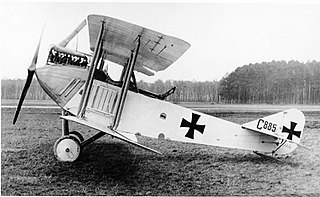
The AEG C.II was a German two-seat biplane reconnaissance aircraft produced in small numbers from October 1915. It was a slightly smaller version of the C.I with better performance, redesigned cockpit for both pilot and observer/bombardier, new rear mounting for a 7.92 mm (.312 in) Parabellum MG14 machine gun, and the ability to carry four 10 kg (22 lb) bombs for light attack duties.

The Friedrichshafen FF.41a was a large, German-built, three-seat, twin-engine floatplane reconnaissance aircraft designed by Flugzeugbau Friedrichshafen in 1917.

The Friedrichshafen G.I was a prototype heavy bomber aircraft that was built in Germany by Flugzeugbau Friedrichshafen in 1915. It was Karl Gehlen's first design for the company, and although it was not produced in quantity, it provided the foundation for the later, highly successful bombers culminating in the G.III.

The Friedrichshafen G.IV and G.V respectively were heavy bombers that were designed and manufactured in Germany during World War I by Flugzeugbau Friedrichshafen. The G.IV saw limited use by the Luftstreitkräfte for tactical and limited strategic bombing operations, while the G.V and a follow-on design, the FF.62 did not fly until after the Armistice.
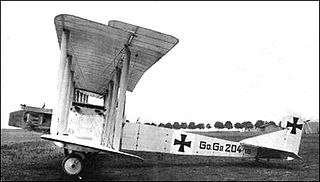
The Gotha G.II series was a heavy bomber used by the Luftstreitkräfte during World War I.

The Gotha G.III was a twin-engine pusher biplane heavy bomber used by the Luftstreitkräfte during World War I. It succeeded the G.II in production and differed primarily in powerplant and in armament details. The G.II's unreliable V-8 Mercedes D.IV was replaced by the new inline six-cylinder 190 kW (250 hp) Mercedes D.IVa engine. The G.III also had a strengthened fuselage with an extra 7.92 mm (0.312 in) machine gun firing through a ventral gun tunnel in the belly to protect the underside of the tail.

The Hansa-Brandenburg W.19 was a German fighter-reconnaissance aircraft of World War I. It was a single-engined two-seat biplane floatplane, and was a larger development of the successful W.12. It served with the Kaiserliche Marine during 1918.

The Friedrichshafen FF.35 was a German three-seat floatplane torpedo bomber built during World War I by Friedrichshafen Flugzeugbau built for the Imperial German Navy's Naval Air Service. Only one prototype was constructed in 1916 and it saw limited operational use during the war in Courland.

The Gotha G.VII was a bomber aircraft produced in Germany during the final months of World War I. With the strategic bombing campaign effectively over, it was intended to be a high-speed tactical bomber with a secondary reconnaissance capability.

The Gotha LD.1 and its derivatives were a family of military aircraft produced in Germany just before and during the early part of World War I. Used for training and reconnaissance, they were conventional designs with two-bay unstaggered wings, tailskid landing gear, and two open cockpits in tandem. Made quickly obsolete by the rapid advances in aviation technology, several were supplied as military aid to the Ottoman Empire when withdrawn from German service.
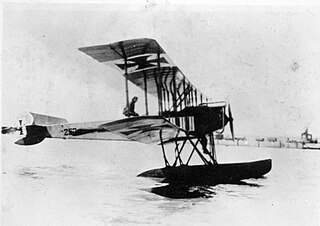
The Gotha WD.2 and its derivatives were a family of military reconnaissance aircraft produced in Germany just before and during the early part of World War I.
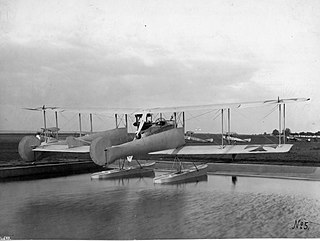
The Gotha WD.3 was a prototype maritime reconnaissance floatplane developed during World War I by Gothaer Waggonfabrik (Gotha) for the Imperial German Navy's Naval Air Service. The three-seat aircraft used the pusher configuration with the engine behind the crew. It was lacking in performance compared to aircraft with the more common tractor configuration with the engine in the nose and was not approved for production. The single prototype completed was used as a training aircraft; its ultimate fate is unknown.

The Gotha WD.7 was a twin-engine maritime patrol and torpedo-bomber training floatplane developed during World War I by Gothaer Waggonfabrik for the Imperial German Navy's Naval Air Service. The WD.8 was a single-engine version of the WD.7 developed for comparative purposes. The single aircraft built was deemed "totally unsuitable" by the Naval Air Service and was later sold to the Ottoman Empire.

The Gotha WD.11 was a three-seat floatplane torpedo-bomber developed during World War I by Gothaer Waggonfabrik (Gotha) for the Imperial German Navy's Naval Air Service. The company's earlier Gotha WD.7 had been moderately successful as a training aircraft for torpedo tactics and it designed a larger and more powerful aircraft along the same general lines. The prototype was completed in 1916 and the aircraft entered service the following year. 17 examples were built and enjoyed limited success, sinking two British freighters in the North Sea. One squadron participated in Operation Albion in 1917 with limited effectiveness. Torpedo shortages and durability issues forced the WD.11s removal from active service in 1918. Fewer than half survived to be inventoried by the Allies after the war.
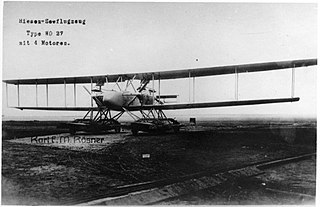
The Gotha WD.27 was a long-range maritime patrol floatplane developed during World War I by Gothaer Waggonfabrik (Gotha) for the Imperial German Navy's Naval Air Service. It was a large, four-engine aircraft with the same general layout as the WD.22; a conventional floatplane with engines grouped in tractor-pusher pairs on the lower wings. Contemporary records show three German Navy serial numbers allocated to the type, but only one of these may have been flown.

The Hansa-Brandenburg GW was a floatplane torpedo bomber produced in Germany during World War I for the Imperial German Navy. In configuration, it was similar to the Hansa-Brandenburg G.I land-based bomber, but the GW was substantially larger and heavier. Like the G.I, it was a conventional three-bay biplane design with staggered wings with the lower wing of slightly greater span than the upper. The undercarriage consisted of twin floats, each mounted on a separate truss structure, leaving space between them for a single torpedo to be dropped from the underside of the fuselage. The metal trusses that had attached the engines to the sides of the G.I's fuselage were not present in this design, with the engine nacelles carried on struts in the interplane gap.

The Zeppelin-Lindau CS.I was a German single-engined reconnaissance seaplane with a low-wing monoplane layout.

The Schütte-Lanz C.I was a German reconnaissance aircraft prototype of World War I.

The Hansa-Brandenburg GDW was a floatplane torpedo bomber built in Germany during World War I for the Imperial German Navy.






















